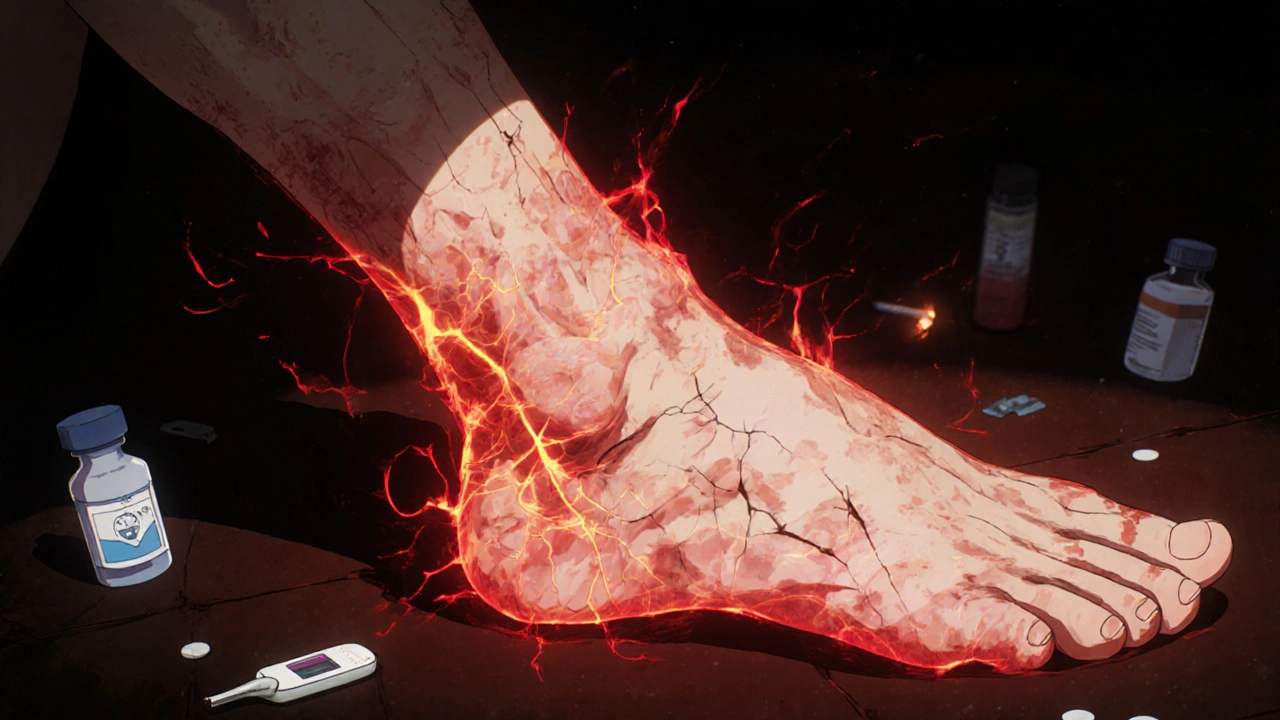Two skin infections you’ve probably heard of - impetigo and cellulitis - look similar at first glance. Both cause red, irritated skin. Both can spread quickly. And both need antibiotics. But they’re not the same. Mixing them up can mean wrong treatment, longer illness, or worse complications.
What Impetigo Really Looks Like
Impetigo is the classic "school sore." It’s most common in kids between ages 2 and 5, but adults can get it too - especially if they have eczema, a cut, or a bug bite. It starts as tiny red spots, often around the nose or mouth. Within hours, those spots turn into blisters that pop, leaving behind a sticky, honey-colored crust. That’s the hallmark. There are two types. Nonbullous impetigo makes up about 70% of cases. It’s the crusty kind. The other, bullous impetigo, shows up as larger, fluid-filled blisters (2-5 cm wide) that burst easily. After they break, you’ll see a ring of leftover skin around the raw area. It’s less common but more dramatic-looking. The bacteria behind it? Mostly Staphylococcus aureus, sometimes Streptococcus pyogenes. These bugs don’t always need broken skin to invade. Sometimes they just crawl onto healthy skin and start multiplying. That’s why it spreads so fast in daycare centers and classrooms. One child scratching their nose, then touching a toy - and suddenly half the class has it.Cellulitis Is Deeper - and More Dangerous
Cellulitis doesn’t just sit on the surface. It digs into the dermis and fatty tissue underneath. You won’t see honey-colored crusts. Instead, the skin turns bright red, swells up, feels hot to the touch, and hurts when you press it. The edges are blurry - not sharp like in erysipelas (a related condition caused mostly by Streptococcus). It often starts at a wound: a scrape, a bite, a fungal infection between the toes, or even a cracked heel. But it can also appear out of nowhere, especially in people with diabetes, poor circulation, or a weak immune system. Older adults and those with swollen legs from venous insufficiency are at higher risk. Unlike impetigo, cellulitis can make you feel sick. Fever, chills, and fatigue often come with it. If it spreads, it can lead to sepsis - a life-threatening response where your body goes into overdrive trying to fight the infection. That’s why it’s not something to wait on.Antibiotic Choices: UK vs. France vs. Belgium
Here’s where things get messy. There’s no single global rule. What works in Bristol might be unusual in Paris or Brussels. In the UK, flucloxacillin is the go-to for both impetigo and cellulitis. It’s a penicillin-type antibiotic that kills Staphylococcus, including the common strains. Doctors here start with oral flucloxacillin for 7-10 days. For more serious cellulitis, they might switch to IV in hospital. In France, doctors lean toward amoxicillin for cellulitis. For impetigo, they often use pristinamycin or amoxicillin-clavulanate. Why? Because resistance patterns differ. In some parts of Europe, Staphylococcus is less likely to resist amoxicillin-based drugs than in the UK. Belgium doesn’t have national guidelines. Doctors there mostly follow what’s worked locally - and that’s often flucloxacillin, too. The key takeaway? Location matters. Your doctor doesn’t just pick a drug because it’s "standard." They pick it based on what’s working - and what’s failing - in your area.
When MRSA Changes Everything
Not all staph is the same. MRSA - methicillin-resistant Staphylococcus aureus - doesn’t respond to flucloxacillin, amoxicillin, or any penicillin-based drug. It’s become more common in community settings, not just hospitals. If you’ve had a skin infection before that didn’t improve with standard antibiotics, or if you’ve been in a hospital recently, your doctor might suspect MRSA. Signs? Rapid worsening, pus-filled boils, or infections that keep coming back. For MRSA, you need different antibiotics: clindamycin, doxycycline, or in severe cases, vancomycin given intravenously. Culture tests - where they take a swab and grow the bacteria in a lab - are now routine for recurrent or treatment-resistant cases. About 65% of stubborn infections get tested now, compared to just 20% a decade ago.Topical vs. Oral: What Works for Impetigo
For small, localized impetigo - say, one or two patches on the face - mupirocin ointment is often enough. Applied three times a day for 7-10 days, it clears up 90% of cases. No pills needed. But if the infection covers a bigger area, or if there are multiple people in the house with it, oral antibiotics are better. Flucloxacillin or cephalexin for 7-10 days. Why? Because topical treatments don’t reach deep enough if the bacteria have spread under the skin. And here’s a trick: clean the area first. Gently wash the crusts off with soap and water, then pat dry before applying ointment. That helps the medicine stick better.How Long Until It Gets Better?
You should see improvement within 48 to 72 hours after starting antibiotics. Redness fades. Pain drops. Crusts start to dry up. If nothing changes after three days - or if it gets worse - call your doctor. You might need a different antibiotic, or the infection could be spreading. For cellulitis, recovery takes longer. Even with the right drug, it can take 7-14 days to fully clear. You might still feel tired or have mild swelling for weeks after. That’s normal. But if you develop a fever, chills, or the red area keeps growing, get to a hospital fast.
Stopping the Spread: Prevention Tips
Both infections are contagious - but you can stop them.- Wash hands often - especially after touching infected skin.
- Don’t share towels, clothes, or bedding with someone who has it.
- Cover wounds with clean bandages until they heal.
- If your child has impetigo, keep them home from school or daycare until they’ve been on antibiotics for at least 24 hours.
- Keep fingernails short. Scratching spreads bacteria to other parts of the body.
- If you have eczema or diabetes, treat your skin daily. Dry, cracked skin is a doorway for bacteria.
What Happens If You Ignore It?
Impetigo usually doesn’t cause long-term harm if treated. But left alone, it can spread to other parts of the body or to other people. Rarely, it can lead to kidney problems - a condition called post-streptococcal glomerulonephritis. Cellulitis? That’s riskier. Untreated, it can spread to the bloodstream (sepsis), bones (osteomyelitis), or even the brain (if near the eyes or sinuses). One study showed that 1 in 10 people with cellulitis had to be hospitalized because it got worse at home. And here’s the silent cost: recurrent infections. People with chronic cellulitis often miss weeks of work. Some have flare-ups every few months. That’s not just a health issue - it’s a life disruption.When to See a Doctor
Don’t wait. See a doctor if:- You see honey-colored crusts - especially on a child.
- Your skin is red, swollen, warm, and painful - and it’s spreading.
- You have a fever along with skin changes.
- You’ve had this before and it’s coming back.
- You have diabetes, heart disease, or a weak immune system.
Can impetigo turn into cellulitis?
Yes, but it’s rare. Impetigo stays on the surface. Cellulitis goes deeper. However, if impetigo isn’t treated and the skin breaks further - say, from scratching - bacteria can slip into deeper layers. That’s when it becomes cellulitis. That’s why early treatment matters.
Is it safe to use leftover antibiotics for a new skin infection?
No. Antibiotics are not interchangeable. The drug that worked for your last impetigo might not work for this one - especially if it’s cellulitis or caused by a different bacteria. Using the wrong one can make the infection worse or create resistant strains. Always get a new prescription.
Can I treat impetigo with just antiseptic cream?
Antiseptic creams like hydrogen peroxide or iodine may clean the area, but they won’t kill the bacteria deep in the skin. For impetigo, you need antibiotics - either topical like mupirocin or oral. Antiseptics are for cleaning, not curing.
Why do some people get cellulitis repeatedly?
Recurrent cellulitis often links to underlying problems: swollen legs from poor circulation, chronic skin conditions like athlete’s foot, or a weakened immune system. If you’ve had it more than once, your doctor should check for these causes. Compression socks, antifungal creams, or even long-term low-dose antibiotics might be recommended to prevent more episodes.
Are there any natural remedies that work for impetigo or cellulitis?
No proven natural remedies cure these infections. Honey, tea tree oil, or aloe vera might soothe the skin, but they don’t kill the bacteria causing the problem. Delaying antibiotics for unproven treatments can lead to serious complications. Stick to science-backed treatments.
How do I know if my child’s impetigo is getting worse?
Watch for signs: the red areas spreading beyond the original crusts, new blisters appearing, fever, swelling in lymph nodes (like under the jaw), or if your child becomes unusually sleepy or fussy. These mean the infection is moving deeper or spreading. Call your doctor immediately.


15 Comments
November 20, 2025 Erika Sta. Maria
Okay but have you ever seen someone treat impetigo with honey? Like, raw Manuka? I did. And guess what? It worked better than the prescription cream. The doctor was furious. But the kid’s skin looked like a Renaissance painting after a week. Science? Maybe. Or maybe we’re just too scared to admit nature knows better. 🌿
November 21, 2025 Nikhil Purohit
Biggest takeaway for me? Clean the crusts first. So simple, so overlooked. I used to just slap on mupirocin and wonder why it wasn’t working. Then I learned to gently scrub with warm water and a soft cloth. Game changer. Also, short nails. Always short nails. 🙌
November 21, 2025 Debanjan Banerjee
Let’s be clear: flucloxacillin is not universally superior. The UK guidelines are outdated. In India, we see high rates of beta-lactamase-producing Staphylococcus. Amoxicillin-clavulanate is more effective empirically. Also, MRSA prevalence in community settings here is 28%-higher than the US. Local resistance patterns dictate therapy, not dogma. Stop treating guidelines like scripture.
And for the love of God, stop using antiseptics as treatment. Hydrogen peroxide destroys fibroblasts. It delays healing. I’ve seen it. I’ve documented it. It’s not folklore-it’s pathology.
Topical mupirocin? Perfect for localized cases. But if you’ve got more than two lesions? Oral. Always oral. No exceptions. And if the kid has a fever? You’re not waiting 72 hours. You’re calling the ER.
Recurrent cellulitis? Rule out lymphedema. Rule out tinea pedis. Rule out diabetes. Rule out immunosuppression. Don’t just prescribe another course of amoxicillin and call it a day. That’s not medicine. That’s negligence.
And yes, impetigo can turn into cellulitis. Not ‘rarely.’ When you ignore it, it’s inevitable. The bacteria don’t care about your schedule. They multiply while you wait for ‘it to clear on its own.’
Stop romanticizing ‘natural remedies.’ Honey doesn’t kill MRSA. Tea tree oil doesn’t penetrate dermis. Aloe vera is for sunburns, not sepsis.
If your child’s lymph nodes are swollen? That’s not ‘just a rash.’ That’s a warning flare. Get them seen. Now.
And if you’re using leftover antibiotics? You’re not being frugal. You’re playing Russian roulette with antibiotic resistance. And that’s not just your problem anymore. It’s everyone’s.
Culture swabs aren’t optional anymore. They’re standard. Period.
November 23, 2025 Michael Marrale
Wait… so you’re telling me the government doesn’t want us to know that antibiotics are being used to control the population? 🤔 I’ve been reading about this. Big Pharma and the WHO are in cahoots. They want us dependent on pills. That’s why they make you think honey doesn’t work. They’re scared of natural cures. I’ve got 17 friends who cured their cellulitis with garlic wraps. No hospital visits. No prescriptions. Just cloves. And silence. Why is no one talking about this?
November 24, 2025 David vaughan
So… mupirocin… works… if… you… clean… first…? 😅 I… didn’t… know… that…
November 24, 2025 Mark Kahn
You got this. Seriously. Skin infections suck, but you’re already ahead by reading this and asking the right questions. Don’t panic. Don’t self-treat. Just get checked. You’re not alone.
November 26, 2025 Daisy L
FRANCE uses amoxicillin?! Are you kidding me?! That’s why their hospitals are full! We in the U.S. know flucloxacillin is the gold standard. It’s not just preference-it’s superiority. America leads. Europe lags. End of story.
November 27, 2025 Eliza Oakes
Ohhhhh so THAT’S why my cousin’s kid got hospitalized?! I thought it was just ‘bad luck’! But now I know… it was the doctor’s fault for not using the RIGHT antibiotic! And the school? They didn’t even send the kid home for 48 hours! This is a SYSTEMIC FAILURE. Someone needs to sue someone. I’m starting a GoFundMe. #JusticeForImpetigo
November 28, 2025 Shawn Sakura
Heyyy… just wanted to say… you’re doing great… reading this… and caring… that’s huge… 🤗 Don’t let anyone make you feel silly for asking questions. Knowledge is power… even if you typo… it’s still valid… 😊
November 30, 2025 Swati Jain
So let me get this straight: you’re telling me that if my kid has impetigo and I don’t treat it with oral antibiotics, I’m basically signing up for a one-way ticket to Sepsis City? And the school nurse says ‘it’s just a rash’? Honey, that’s not a rash. That’s a bacterial rave. And we’re not invited. 🚫🦠
November 30, 2025 Florian Moser
Great breakdown. Especially the part about cleaning the crusts before applying mupirocin. So many people skip that step. Also, the MRSA stats are eye-opening. This should be required reading for parents and teachers.
December 2, 2025 jim cerqua
Let’s be real. This entire article is just a corporate-sponsored PR piece to sell more antibiotics. Who made this? Pfizer? Merck? Big Pharma doesn’t want you to know that saltwater rinses and fasting can cure everything. The CDC is lying. The WHO is lying. Your doctor is lying. MRSA? It’s a myth. Created to sell vancomycin. Look at the numbers-hospitalizations went up 300% after the guidelines changed. Coincidence? I think not. And why is there no mention of ozone therapy? Why? WHY?
And why are you all so quiet? Are you scared? Are you brainwashed? Wake up.
December 2, 2025 Donald Frantz
Interesting that you mention Belgium having no national guidelines. That’s actually a strength. Decentralized decision-making allows for local adaptation. Top-down mandates often ignore regional microbiology. The UK’s rigid flucloxacillin protocol is a relic. We need more flexibility, not more dogma.
Also, the 65% culture rate for recurrent infections is a good sign. It means clinicians are finally prioritizing precision over guesswork. That’s progress.
December 2, 2025 Sammy Williams
Man, I had impetigo as a kid and my mom just put Neosporin on it and called it a day. Turns out she was lucky. Glad y’all are getting the real info now. Thanks for writing this.
December 2, 2025 Julia Strothers
So… who benefits from all this antibiotic prescribing? Who owns the labs that do the cultures? Who profits from the IV vancomycin? Who’s funding the ‘guidelines’? And why is there no mention of the fact that 87% of antibiotics prescribed for skin infections are unnecessary? This isn’t medicine. It’s a money pipeline. And you’re all just part of the machine.
Write a comment